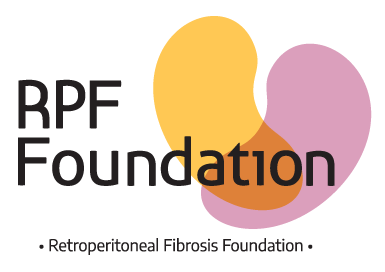
1. How did you first become aware that something might be wrong?
In 2015, I experienced a mild cough and fever, was hospitalized, and underwent surgery due to a suspected lung cancer diagnosis. One lobe of my lung was removed, but the biopsy revealed a pulmonary fibroelastoma. After surgery, I began to sweat easily and occasionally experienced shortness of breath. In June 2016, I developed a persistent fever of around 38°C that lasted for five days.
2. What symptoms led you to seek medical attention?
In June 2016, I had a fever of approximately 38°C for five consecutive days. Shortly afterward, I was unable to urinate. Blood tests revealed my creatinine level had spiked—about 15 times higher than normal. Imaging tests showed that both ureters were obstructed by fibrosis.
3. How long did it take to receive a diagnosis after your initial symptoms appeared?
It took about two months to arrive at a suspected diagnosis of retroperitoneal fibrosis (RPF) in China. However, a biopsy to confirm the diagnosis couldn’t be performed due to the proximity of the fibrosis to the aorta. The diagnosis was finally confirmed at Mayo Clinic in October 2016.
4. What tests and procedures were performed to diagnose your condition?
I underwent multiple CT scans with contrast and two PET-CT scans in China, which led to a suspected diagnosis of RPF. A definitive diagnosis was made at Mayo Clinic via biopsy in October 2016.
5. How did you feel when you received your diagnosis?
In China, I felt hopeless and uncertain. After receiving the diagnosis at Mayo Clinic and experiencing the professionalism of the medical team, I felt immense relief and reassurance.
TREATMENT
6. What treatment options were presented to you?
I was prescribed Prednisone and CellCept, with dosages gradually increased. Bilateral ureteral stents were placed and changed every three months. Once the fibrosis had shrunk to an acceptable level, under Dr. Koster’s arrangement, I underwent ureterolysis performed by an excellent Mayo Clinic urologist, Dr. Chow.
7. Which treatment(s) did you choose and why?
I followed the treatment plan recommended by the Mayo Clinic doctors because of their professionalism and their confidence in managing my condition. Dr. Koster led the communication between different teams at Mayo.
8. How did you feel about the information and support provided by your healthcare team regarding your treatment options?
I felt incredibly grateful and reassured. The Mayo Clinic team was thorough, professional, and supportive throughout the entire process.
9. Were there any side effects or complications from the treatment? If so, how were they managed?
Early in my treatment (November 2016), the enlarged fibrosis compressed pelvic veins and caused blood clots. Two stents were placed in the veins to address this by another excellent Dr. Kendle at Mayo. Prednisone caused weight gain and fatigue, which were managed over time.
10. How effective was the treatment in managing your symptoms?
Prednisone and CellCept were highly effective in shrinking the fibrosis. About a year later, after the fibrosis had significantly shrunk, the ureterolysis surgery eliminated the need for frequent stent replacements.
OUTCOMES
11. How has your condition changed since starting treatment?
My quality of life has significantly improved. I no longer live in fear of RPF or the suffering it caused. My Retroperitoneal fibrosis has disappeared after 8 years, Dr. Koster, I, and my family are all thrilled. We are so grateful for Dr.Koster's great care over the last 8 years.
12. Have you experienced any relapses or improvements?
Yes, I’ve experienced substantial improvements in nearly every aspect of my life.
13. How often do you need to follow up with your healthcare provider?
I now do blood tests every two months and annual CT scans with contrast of the chest and pelvis (previously every three months, then six). I also see Dr. Koster once a year instead of twice.
14. What has been the most challenging aspect of managing your condition?
The most challenging part was finding the right healthcare team for an accurate diagnosis, and managing the fatigue and uncertainty brought on by both the disease and its treatment.
QUALITY OF LIFE / LIFESTYLE
15. How has retroperitoneal fibrosis affected your daily life and activities?
In China, I suffered greatly from repeated infections and high fevers caused by stent complications, and struggled through visits to multiple specialists without a clear diagnosis. My daily life became extremely difficult. Since coming to Mayo Clinic, however, I’ve felt uplifted and no longer live in constant fear or anxiety. Under the care of Dr. Koster and his team, my life has dramatically changed for the better.
16. How has your condition impacted your mental and emotional well-being?
Before my diagnosis at Mayo, I experienced fear, desperation, anxiety, and hopelessness—at times feeling that life was worse than death due to the constant suffering and pain. Since then, I’ve become much more optimistic. Dr. Koster’s constant support—both emotional and professional—has played a major role in that transformation.
17. What support systems (family, friends, support groups) have been helpful to you?
My daughter relocated with me to Rochester, close to Mayo Clinic. Her presence provides constant support and peace of mind. She takes care of me in every aspect of daily life.
18. Are there any lifestyle changes you have made to better manage your condition?
Yes. I’ve remained active since 2017, walking around 8,000–10,000 steps daily. Due to age, I now average 7,000–8,000 steps per day. In 2020, I adopted a low-carb, low-sugar (Paleo) diet. It has helped me feel more energetic and maintain better physical health. I also wear an Oura Ring, which tracks my daily activity and motivates me to stay active and maintain a structured, healthy lifestyle.
19. What advice would you give to someone newly diagnosed with retroperitoneal fibrosis?
Finding a responsible and capable healthcare team is critical. I highly recommend Dr. Koster and his team at Mayo Clinic. Their expertise and professional care saved me.
20. How has your condition impacted your caregivers or family, and what challenges have they faced in supporting you?
My daughter left her job to care for me full-time. She devotes most of her time to ensuring I live a healthy and stress-free life. She is extremely cautious—always wears a mask to protect me from infections. This is especially important since I’m 85 and taking CellCept, which compromises my immune system. I’ve had multiple infections related to RPF in the past, so her care is vital to my well-being.
GENERAL FEEDBACK
21. What do you think could be improved in the diagnosis and treatment process for retroperitoneal fibrosis?
Accurate and timely diagnosis is essential. If a reliable diagnosis could someday be made through blood tests or imaging—without the need for a biopsy—it would significantly speed up care and make diagnosis more accessible globally.
22. Is there anything else you would like to share about your experience?
The important lesson I’ve learned is to find the best doctors, put your trust in them, follow their advice, and share detailed, well-recorded symptoms with them. Most importantly, remain deeply grateful to your doctors and their team. Gratitude itself can be healing.



